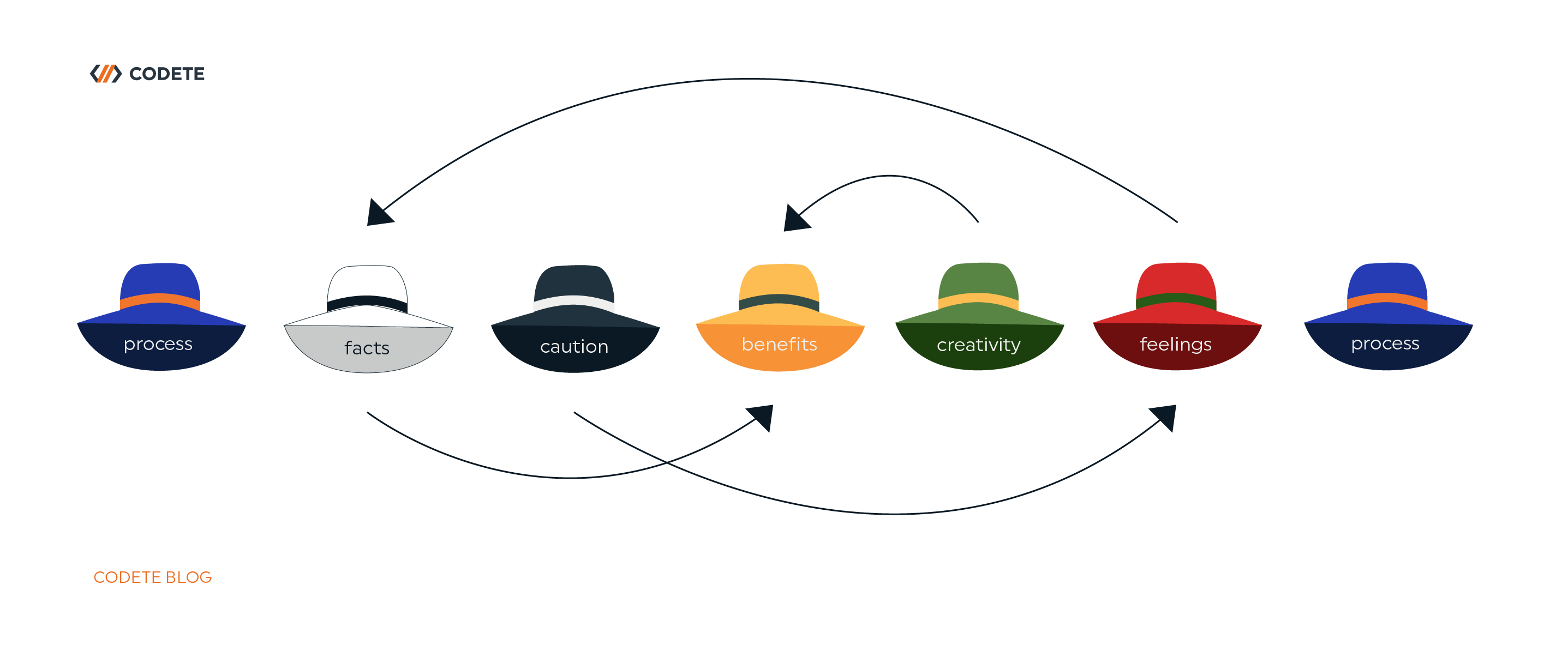We have all heard that we should walk a mile in someone else's shoes before we judge them, but did you know that it may prove useful to wear different hats before you make an important decision? Six Thinking Hats, to be exact.
Read on to find out what the Six Thinking Hats method is all about, how it can help you and your team in making better decisions, and how to make the best of it in practice.
Table of contents:
- Six Thinking Hats explained
- Six Thinking Hats colors
- How to facilitate Six Thinking Hats sessions?
- Key takeaways
Six Thinking Hats explained
Six Thinking Hats is a technique for improving your decision making process by "trying on" different perspectives represented by different thinking hat colors. The term was coined by Dr. Edward de Bono in 1985, when he published his "Six Thinking Hats" book – a practical followup for business managers to his concept of Lateral Thinking (first introduced in "The Use of Lateral Thinking" in 1967).
What is Lateral Thinking? Simply put, it is a creative approach to solving problems. Instead of following the traditional Western step-by-step way of thinking, in Lateral Thinking you look at a problem in a fresh, non-standard way – to come up with fresh, non-standard solutions. You question the status quo and break the usual thinking patterns to generate new ideas.
Then, the Six Thinking Hats method comes in.
How does the Six Thinking Hats technique work?
Basically, the Six Thinking Hats model is a technique for thinking ideas through by applying different perspectives. There are six perspectives in this framework, and each is represented by a metaphorical colored hat of its own:
- Blue Thinking Hat – represents the process,
- White Thinking Hat – represents facts,
- Red Thinking Hat – represents feelings,
- Yellow Thinking Hat – represents benefits,
- Green Thinking Hat – represents creativity,
- Black Thinking Hat – represents caution.
We'll go through them in detail later on, but you probably get the gist of the method now: it's a way of looking at a given problem from different angles. Ultimately, this should lead you to making better (or at least better thought out) decisions.
It should be also emphasized that Six Thinking Hats is a structured approach – this is especially important in the business context, as it allows for more orderly and productive meetings. This is what makes this technique different from traditional brainstorming, which tends to be more chaotic.
Whatever someone says is treated as a fact – we don't argue with it. If there's something you don't agree with, however, you can address it when the time for a suitable hat color comes (for example, if you want to criticize a fact somebody mentioned before, you can do it during the Black Hat time slot).
When to use Six Thinking Hats?
You can use the thinking hats technique to analyze all sorts of problems in both your personal and professional life, but let's focus on the latter here. Some situations in which Six Thinking Hats may come in handy are:
- Analysis of strategic choices
- Risk management
- Solving issues that evoke a lot of emotions
Benefits of the Six Thinking Hats method
But what are the benefits of running a thinking hats session instead of a regular brainstorming meeting?
- Firstly, these sessions are based on a structured thinking process – this naturally leads to better meetings, meaning: more productive meetings.
- An imposed structure also ensures better analyzed decisions – in the Six Thinking Hats model, we explore problems from several perspectives. You get a checklist of viewpoints, so to say, that create opportunities for finding possible solutions.
- Lateral Thinking is designed to generate ideas and bring more creative solutions to the table. With this approach – which promotes questioning the status quo – your team can ideate new and surprising ways of solving problems.
- Properly facilitated, a thinking hats session is conflict-free and enables all participants to speak their minds freely without fear of being judged – that's because potential critique cannot be directed at the speaker, and the spoken statements cannot be criticized immediately (only in the designated parts of the discussion).
How to introduce Six Thinking Hats to a team?
If you're a Project Manager or Team Leader responsible for facilitating team discussions, it's worth giving the thinking hats a try. It's not an invitation to bid goodbye to classic brainstorming for good, but introducing a new approach to decision making and analyzing problems may feel like a breath of fresh air and prove beneficial.
Before running your first Six Thinking Hats meeting, explain the method, the hat colors, and the rules to your team. Perhaps the key difference between this framework and brainstorming is that at a given point, the whole team is supposed to focus on one particular hat/viewpoint. We don't discuss statements (or, as you will, facts) or argue with them.
Later on in the article, you will find all the hat color explanations, as well as a couple of best practices to follow and common mistakes to avoid.
Six Thinking Hats colors
During a thinking hats session, the participants "put on" different hat colors – this means that at the designated time, they all adopt a certain perspective. Besides that, each meeting has its facilitator, who controls the tempo of the discussion. The facilitator also puts on the colored hats, together with the rest of the participants.
Below, you will find the details of every hat color/mode of thinking.
Blue Thinking Hat
Blue hat is the process hat, the control hat – it's responsible for organizing our thinking process, summarizing the discussion, preparing plans for action. It facilitates the meeting, pushes it forward, and draws conclusions.
The Blue Thinking Hat usually appears twice: at the beginning and at the end of every session. First, to arrange the order of the hats, then – to close the meeting in a constructive manner.
White Thinking Hat
White hat is the neutral, fact-focused hat. These facts can be either verified or not (hypotheses). "Always", "usually", "most of the time" sort of things are those kinds of statements that typically belong in this slot.
When we put on the White Thinking Hat, it's good to ask additional questions about the facts others mention, to make sure we get as many useful details as possible. Take a look at this example:
- "All women know that you should undergo regular health check-ups when you're pregnant" is too broad a statement, and you can easily tell that it's likely untrue.
- "The majority of pregnant women are aware that they should undergo regular medical check-ups during their pregnancy" sounds more specific as well as more probable.
Red Thinking Hat
The red hat is all about emotions and gut reactions. The goal here is to let out all of our feelings and hunches connected with the subject, so that we can move on to other hats without their weight on our shoulders. The Red Thinking Hat time slot is especially valuable when we discuss hot, controversial topics (just think of a COVID-19 vaccines-related debate).
The important thing here is that we shouldn't judge, criticize, or undermine someone else's feelings. We can ask about them, but not force the person to justify them. What is welcome, however, is being proactive and creating a welcoming environment for everyone to share their emotions:
- "Is it OK for you?"
- "How do you feel about it?"
Yellow Thinking Hat
The yellow hat is synonymous with opportunities – it's the hat that helps us focus on positive outcomes of the case we discuss. Surprisingly, it can be more difficult than you'd think to leave out all the doubts.
Sometimes, it takes some digging to find the bright side to a fact, or some imagination to come up with an optimistic scenario. But the goal here is to actively search for benefits of our situation, and leave the risks to the black hat time slot.
Green Thinking Hat
The green hat is the creativity hat. This is the time to produce as many ideas as possible – all ideas are welcome, we don't judge them. At this point, we aim at imagining the different ways our case in question could develop:
- What are the other options?
- Are there any alternative routes we could take?
- If not this, then what?
Black Thinking Hat
The black hat is cautious and somewhat pessimistic. At this point, we focus on the negatives: risks and things that may go wrong. It may not exactly be fun, but it's important for our safety – or, in the business world, the success of our project.
This is a good time slot for commenting on previously mentioned facts if we think they are overly optimistic or lack important details, but remember: don't make it personal. It's fine to pinpoint mistakes, but not to criticize the person who made the statement.
You can say, for example: "The risk I see here for the project, is that the data is incomplete." instead of: "With the poor quality data you gave us, the project is going to fail."
How to facilitate Six Thinking Hats sessions?
After you've gone through all the hats descriptions, you may wonder:
- Do the hat colors always come in the same order?
- Is it a fixed sequence, or can I adjust it?
- Can we discuss the risks first and then move to something more positive?
The short answer is: the method gives us a lot of freedom in arranging the hat colors, but it's best to start and finish with the Blue Thinking Hat.
The order of hat colors in Six Thinking Hats method
It is advised to commence and conclude your thinking hats session with the Blue Thinking Hat for best process control. This way, in the beginning, you will make sure that everyone is on the same page with the topic and plan of the meeting. At the end, you will secure a productive outcome.
What happens between the two blue hats' time slots, is up to you. You can juggle the hats in the middle depending on the subject or situation:
- When the topic stirs up a lot of emotion, it's good to start with the red hat thinking – this will allow the participants to get the emotions out of their system before moving on to other colors.
- In more analytical topics, it may be beneficial to start with the white or black hat thinking – to gather all the facts and risks first, then look for alternatives. Here, the emotions may come last. It can prove beneficial to finish with the optimistic hat (yellow), so that the meeting ends on a positive note.
Thinking Hats Meetings Do's & Don'ts
Here are a couple of practical tips for facilitating productive Six Thinking Hats meetings.
Best practices
- Start and finish with Blue Thinking Hat: the blue hat is responsible for the thinking hats process itself, that's why initiating and ending your meeting with this color will allow you to start smoothly and finish with summary and conclusions. This way, the session will have proper opening and closure.
- Open questions: To keep the discussion lively and creative, avoid asking simple "yes" or "no" questions, and use open questions instead. They are much more stimulating, and give the meeting participants more room for expressing their thoughts.
- Provocation: You may want to try saying something provocative (like something that seems pointless or silly at first) that will wake up the participants and stir up a conversation leading to constructive conclusions.
Common mistakes
- Focusing on one hat color too much: Especially when the discussion topic is controversial, the participants may have the tendency to burn out by venting all their negative emotions in the Black Hat slot, and have little brainspace and energy left for other colors. Make sure to give all the colors the same amount of attention.
- Arguing with facts: facts, as in "what others say". As mentioned above, the things we say during a thinking hats session are treated as facts and shouldn't be argued with. At least not immediately – that is, when a participant starts to comment on another person's idea, you should ask them to address the issue in a suitable hat color slot.
Key takeaways
To summarize: the Six Thinking Hats technique, devised by Edward de Bono in the mid-80's, is an interesting approach to better decision making.
Making use of de Bono's Lateral Thinking concept and applying a structure to what otherwise would probably be a traditional brainstorming session, the thinking hats can help Project Managers and Team Leaders hold more productive meetings that engage the whole team in generating ideas. The model is flexible and promotes open discussion, yet avoids conflicts. Most importantly, the framework enables investigating any problem from a variety of different perspectives, ensuring well thought through decisions.
Have you tried the Six Thinking Hats technique already? What were the biggest benefits and challenges of this approach for you? Feel free to share your experiences (or questions, if you have such) in the comments section.
And if you need assistance in building and/or leading a development team to successfully build your digital product, don't hesitate to contact us! Codete can offer you assistance on all stages of the product development process, from ideation to delivery. Check out our consulting services, meet our consulting experts, and tell us about your projects – our Consulting Manager will get back to you shortly. Visit: consulting.codete.com >



